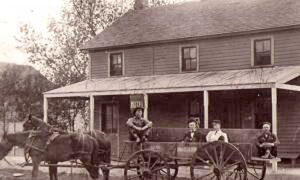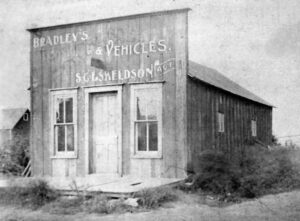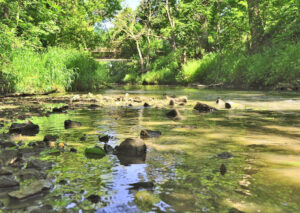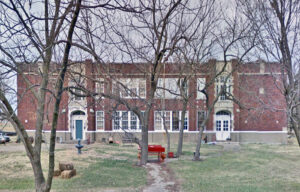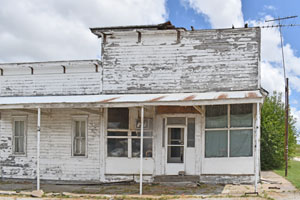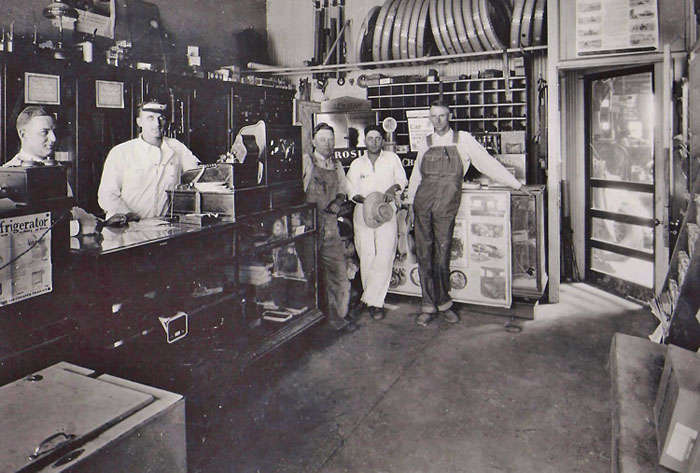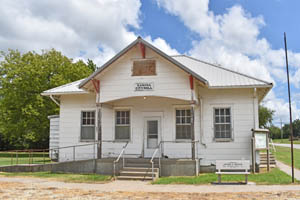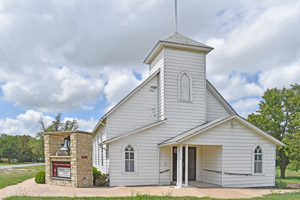Ramona, Kansas, is a small town in the Colfax Township in northern Marion County. As of the 2020 census, the city’s population was 78, and the town had a total area of 0.31 square miles, all of which was land. The county line is just a half mile north of Ramona.
In 1855, Marion County was established within the Kansas Territory.
Land ownership in the Ramona area dates back to when Spain controlled it. Manuel Lisa, a New Orleans merchant, petitioned his government for a large land grant on July 16, 1799. Ramona is a Spanish name. Marion County deed books show that Manuel Lisa had 6,439.32 acres in present day Marion County, and the Ramona area was part of this acreage. When Manuel Lisa died in 1820, he willed half of his land to his nephew and the other half to his wife, Mary. After Mary died, her executor sold the land to A.W. Allen of Kansas City for $4,804.58 in 1870.
The Ramona area was one of the last to be settled in Marion County. The first settlers, many of whom were of German ancestry, arrived in the late 1870s and early 1880s.
On March 22, 1884, a few Ramona settlers met at a private residence to discuss organizing Ramona’s first school. Three months later, an election was held to vote for a bond issue to construct a school building. The first elementary school was built a mile west of Ramona, on the corner of present-day 360th and Pawnee. School District #90 was established the same year. J.B. Shields was the first teacher at this school.
Strickler & Co., founded by the J.S. Strickler family, became Ramona’s most prominent general store. Joseph Strickler came to Marion County from Virginia with his family of 11 children. He also built a grain elevator on the railroad property. As the mercantile prospered, Stricker built a larger store on the west side of Main Street at the south entrance into town. His five sons helped run the store and the elevator. The store served the community for over 70 years until an unfortunate fire in February 1955 destroyed the building. However, the elevator is still a prominent landmark, later owned and operated by Agri-Producers of Tampa, Kansas.

Grain elevators in Ramona, Kansas today, courtesy of Google Maps.
The Golden Belt Town Company was incorporated in 1886. It was chartered to buy and sell land on the right of way of the Chicago, Rock Island, and Pacific Railway in south-central Kansas, including the Waldeck, Durham, Tampa, Ramona, Lincolnville, Furley, and Peck communities. The company also owned an undivided one-half interest in the Lost Springs, Aulne, Elbing, Whitewater, and Gladys townsites. The speculative Golden Belt Town Company founded the town, which filed a town plat in April 1887.
One of the first buildings constructed on the main street after the railroad came through was a boarding house operated by the Ausherman family. The Aushermans came to Kansas from Pennsylvania in the early 1880s and settled north of Ramona. They farmed and operated a postal station on the route from Abilene to Marion, and when Ramona was established, they built the two-story Ramona Hotel on the west side of the main street.
In 1887, Daniel Merilatt established the first general store in a two-room building on the west side of the main street, a short distance north of the first intersection in town. Later, the building would be used as the first bank and later as a restaurant.
The same year, the Chicago, Kansas, and Nebraska Railway built a main line from Herington through Ramona to Pratt. That year, a post office was established in the Ramona Hotel on August 9, 1887. The Ramona Hotel offered accommodations for railroad workers building railroad lines through Kansas. Tom Urie, one of the railroad’s early telegraph operators, lived at the hotel and assisted with postal work. He married the Ausherman’s daughter, Metta, the first postmaster.
The hotel also offered lodging to traveling salesmen, called “Drummers,” who traveled by train with their trunks of merchandise samples, calling on Ramona merchants to take orders. The hotel also served meals for the traveling public and the local business people. It was a valuable asset to the community, and the post office remained in the hotel for over 20 years. Eventually, Henry Beltz tore down the hotel, and the lumber was used to build a farmhouse northeast of town.
One year before the railroad came through, Marion County’s population was 767. Ten years later, after the railroad arrived, the county’s population was 12,471.
With the railroad’s arrival, large groups of immigrants, especially the Dutch-German-Russian Mennonites, were possible. Railroads advertised the advantages of Kansas throughout the eastern United States and even Europe, distributing printed leaflets in Dutch, German, Swedish, Danish, French, and Russian about the opportunities in the Midwest.
The railroad line was extended to Liberal, Kansas, in 1888. Later, it was extended to Tucumcari, New Mexico, and El Paso, Texas. Three years later, the Chicago, Kansas, and Nebraska Railway was foreclosed in 1891 and overtaken by the Chicago, Rock Island & Pacific Railway. It was the first station southwest of Herington.
The Rock Island and Atchison, Topeka & Santa Fe Railroad built tracks that crossed each other just northeast of Ramona. This crossing became known as “Jacob’s Crossing,” named after the Jacobs family, who were early settlers in this area.
To service the trains with water, the Santa Fe Railroad built a large water tank on the right-of-way so steam locomotives could replenish their water tanks. The train companies also built a pump house and a dam to hold the water on Lyon Creek. Water from the dam was pumped to the tank, which towered about 42 feet in the air. The dam also created a nice wide body of water that the locals enjoyed as a summer swimming hole and ice skating in winter. The railroad also had a stockyard at Jacob’s Crossing. Cattle were shipped to this station and kept to rest overnight or contained by ranchers for dehorning. There was a caboose depot near the water tank, where travelers could wait. Once on the train, they purchased tickets from the conductor.
In 1899, the school site was changed from out of town to a plot of land on the southeast corner of Ramona, on land owned by J.M. Potter. The community soon outgrew the building, which was sold to the Church of the Brethren. They moved the building north of the schoolyard and remodeled it as their church. A new two-story school building was then constructed to replace it. In 1905, lightning struck it and could no longer be used. Soon, a larger building with two stories and four large rooms was constructed. In 1909, a high school was added to the elementary school.
Brothers-in-laws S.C. Eskeldson and Pete Sondergard came from Denmark. When Sondergard first came to this area, he was employed as a blacksmith for the railroad in Herington and decided to start his own business in Ramona. He asked Eskeldson, a wheelwright, to join him. Since replacement parts for farm machinery and wagons were unavailable, one had to turn to a blacksmith to find the needed parts. Before long, the pair added a dealership for McCormick-Deering Farm implements, which was very successful because the population was increasing, and the demand for implements was rising along with it. He also built a hardware and implement building and continued his business. In 1915, he sold the business. Later, the building was used as a restaurant on the first floor and a theater on the second floor.
In the early 1900s, Ramona had six churches: River Brethren, Dunkard, Methodist-Presbyterian, Holiness Mission, St. Paul Lutheran, and Trinity Lutheran.
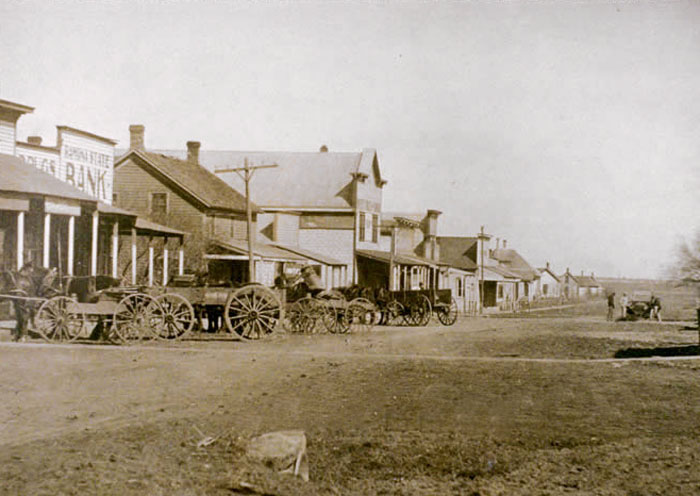
Early Day Ramona, Kansas.
The pair also opened a Ford dealership called the Ramona Garage, which was very prosperous during the heyday of the motel-T Ford. However, competition from the new Model-A Fords and the 1928-29 Chevrolets impacted the Ramona Garage business, so Eskeldson sold his interest in the business to his partner, Sondergard, who took on new partners. The Ramona Garage was sold in 1945. It continued to be operated by various owners for decades, primarily as a gas station and a repair business. The building collapsed in 2001 after a heavy snowstorm.
In 1901, the Mutual Telephone Company was organized in Ramona. The office was first held in the home of N.P.J. “Pete” Sondergard, who built an addition to his home for this purpose. There were four divisions for rural telephone service; each rural line was responsible for maintaining its lines and collecting the monthly service fees paid to the company. Telephone lines connected each residence; several homes were on “party lines.” A trunk line was built to connect Ramona with neighboring towns and Marion so long-distance service could be secured through the Bell Telephone system. Ramona had free service to Herington, Hope, Lost Springs, Tampa, and Pilsen, but people could also connect to other Telephone Exchanges beyond this area. The local operator handled fires, emergencies, and family problems. As there was no fire department in those days, if a call came in about a fire, the operator would alert all the neighbors, and everyone in the area went to help. The reception was often very poor because the connection went through many switchboards.
The same year, A.G. “Archie” Greer and his sister, Marie, built a store on the northwest corner of Third and D Streets. Hailing from Ireland, they first worked in New York City before making their way to Ramona. The building was initially used as a combination cream station and grocery store. This small grocery continued in business throughout the next 100 years, owned by various people. It finally closed in 2000 and was later utilized as a restaurant.
In 1902, Abraham Lincoln Beltz moved near Jacob’s Crossing and built a new creamery near the Santa Fe and Rock Island Railroads’ water refueling station. He also built an icehouse near Lyon Creek, where the dam was located. In the winter, he and his sons cut ice blocks to store in the icehouse to keep their butter and ice cream cold for shipping. The Pleasant View Creamery operated for the next two decades, buying cream, milk, and eggs from local farmers.
The Ramona Oil Company was started because automobiles were becoming more prominent. Howard Button built a bulk gas station on the triangle of land just north of the railroad tracks at the present-day intersection of 3rd and F Streets. Large storage tanks and pumps were on this land, with a pipeline running to the railroad siding since gasoline was shipped in by tank car. When he began the company, Button was a farmer, but as business flourished, he eventually gave up farming. The Durham Oil Company bought the business in 1929, followed by other owners.
To incorporate in 1909, there had to be at least 250 citizens to qualify as a third-class city. It petitioned for incorporation on December 14, 1909, and the Board of County Commissioners approved it on January 3, 1910. At that time, the village was still on the Chicago, Rock Island, and Pacific Railway and was the shipping and receiving point for a prosperous agricultural and stock-raising district. It had a bank, telegraph and express offices, a large local trade, and a money order post office with one rural route and a population of 175.
Ramona’s population peaked in 1920 at 303. Afterward, people began moving out.
By 1924, the school was too crowded, so two brick school buildings—one for grade school students and another for high school students—were necessary. The first step was consolidating the five surrounding rural districts with the “home district” #90. Meetings and elections were held, but in the end, only one of the rural districts — Lincoln — chose to consolidate with Ramona. These two districts voted to build a new grade school in Ramona, costing approximately $35,000. The school was completed and occupied on January 10, 1926. This modern building had two stories, seven classrooms, two restrooms, and a steam heating system.
A high school building was also needed. On April 20, 1925, a vote was held, and the school board was authorized to issue and sell bonds for $45,000. Work began that summer, and the school was completed a year later. The first floor had an academic classroom, a two-room suite for Home Economics and the Manual Training Departments, and a large auditorium/gymnasium. The second floor contained three classrooms, a study hall, a library, rooms for the Science Department, the superintendent’s office, and a balcony for the auditorium. The new Rural Ramona High School was dedicated on February 19, 1926. In the first year, the enrollment was 42; in the following years, the high school enrollment would swell to more than 60, on average.
One of the oldest structures in Ramona is the former Badger Lumber Company, located on the east side of the main street at the south entrance to town. The Badger Lumber Company also had lumberyards in Herington, Marion, Elmo, Hope, Abilene, Tampa, and Durham. It temporarily closed during the Great Depression but later re-opened and operated for another ten years. Later, it was used as a restaurant and an antique store. The building is vacant today.
In 1927, the Tatge brothers—Harlan and Edwin—purchased the Brubaker building and established a dealership for John Deere farm implements and Chevrolet automobiles. Farm implement demonstration days were an annual event, attracting crowds from far and near. The Tatge brothers were astute businessmen, employing many in the community. New farm implements were difficult to obtain during and after World War II, so the Tatge brothers searched several states for used machines and hauled them to Ramona. Deserving much credit for their foresight and initiative, they used the good parts from several machines to make one really good one. They were an asset to Ramona for over 20 years.
Other Ramona businesses over the years included a shoe and harness shop, cream stations, a jewelry and watch repair shop, and a drug store operated by the resident doctor, Doc Saylor.
As locomotives switched from steam to diesel power, the need for the water tank was eliminated. Eventually, the stockyard was razed, the caboose depot burned to the ground when transients took hay into the building to keep warm and sleep down, and the dam on the creek was blown. Lyon Creek is back to being just a small spring-fed stream.
In 1949, the telephone service moved to a building on the west side of the street, just north of the bank building. It no longer stands today. The telephone service was sold to the Tri-County Telephone Association in 1969, and it began operating a dial service in October of that year.
In the 1950s, school enrollment began to decline; more towns could not support their schools independently, and they were soon consolidated. The last graduating class at Ramona High was in 1957. The consolidated school—serving Ramona, Tampa, Lost Springs, Lincolnville, and Burdick—was named Centre. The grade school facility was located in Lost Springs; the high school was built on Highway 77, southeast of Lost Springs.
In 1952, there were 15 businesses in Ramona, including Strickler’s Mercantile, Curly’s Barbershop, Lizzie Mohn’s cream station, Oscar Applegate’s real estate office, Grover Anderson’s grocery store, Jack Anderson’s post office/hardware store in the same building, and the Ohm’s restaurant. There was also a bank, the central telephone office, a gas station owned by Henry Albright, Marie Hicks’s liquor store, Alvin Sader’s television repair shop, the Sader Café, the elevator, and the train depot.
The Chicago, Rock Island, and Pacific Railway shut down in 1980 and was reorganized as the Oklahoma, Kansas, and Texas Railroad. It merged in 1988 with Missouri Pacific Railroad and finally merged with Union Pacific Railroad in 1997. Most locals still call this railroad “Rock Island.”
In 2010, the Keystone-Cushing Pipeline (Phase II) was constructed near Ramona, north to south through Marion County, with much controversy over road damage, tax exemption, and environmental concerns.
In 2011, the Centre Elementary in Lost Springs closed, and the students relocated to the high school facility on Highway 77. The school is now called Centre K-12.
Today, locomotives still pass through Ramona along the Union Pacific Railroad, and its post office is still open. There are many homes and several abandoned business buildings on the main street, and the Trinity Lutheran Church continues to serve parishioners.
Ramona is located in the scenic Flint Hills, about 19 miles northwest of Marion.
© Kathy Alexander/Legends of Kansas, June 2024.
Also See:
Santa Fe Trail in Marion County
Sources:
Blackmar, Frank W.; Kansas: A Cyclopedia of State History, Vol I; Standard Publishing Company, Chicago, IL 1912.
Kansas Memory
Ramona, KS
Wikipedia


